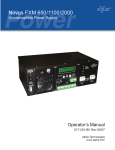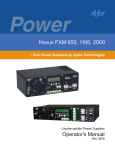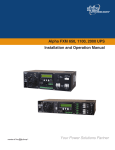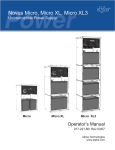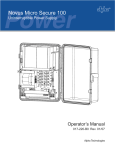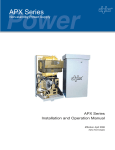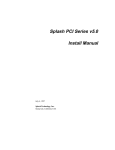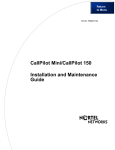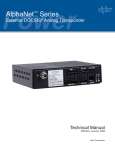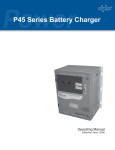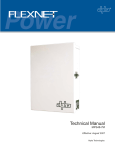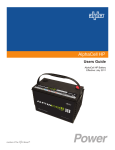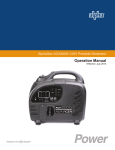Download Alpha Novus FXM 1100 Operator`s manual
Transcript
Novus FXM 500 / 1100 / 1500 / 2000 Uninterruptible Power Supply Operator’s Manual 017-201-B0 Rev. E5 Effective: January 2006 Alpha Technologies Power Alpha Technologies ® Operator’s Manual Novus FXM 500 / 1100 / 1500 / 2000 Uninterruptible Power Supplies From Alpha Technologies 017-201-B0 Rev. E5 1 / 06 Novus FXM 500/1100/1500/2000 Operator’s Manual Save This Manual: It contains important installation and operating instructions. Keep it in a safe place. Table of Contents The emergency shutdown procedure is on the inside rear cover 1. Introduction........................................ 1 4. Communication................................ 30 1.1 Safety Checklists................................................... 2 1.1.1 UPS Safety Checklist....................................................... 2 1.1.2 Battery Safety Checklist................................................... 3 1.2 Unpacking and Inspection Checklist...................... 4 1.3 The Novus FXM Front Panel................................. 5 1.3.1 FXM 1100, 1500, 2000.................................................... 6 1.3.2 FXM 500........................................................................ 10 2. Installation........................................ 11 2.1 Site Preparation Checklist................................... 12 2.2 Mounting the UPS............................................... 13 2.3 Wiring the External Batteries............................... 14 2.4 Wiring the UPS.................................................... 16 3. Operation.......................................... 17 3.1 Operating the Control Panel................................ 18 3.2 Turning the UPS On and Off................................ 20 3.2.1 Turn On.......................................................................... 20 3.2.2 Turn Off.......................................................................... 21 3.3 Battery Replacement........................................... 22 3.4 Operating the UPS.............................................. 23 3.5 Making Measurements........................................ 25 3.6 Troubleshooting................................................... 27 3.7 Last Event Log..................................................... 29 4.1 Wiring the RS-232 Port........................................ 31 4.2 Using the Main Menu........................................... 32 4.2.1 Main Menu Screen......................................................... 32 4.2.2 RS-232 Menu Tree......................................................... 33 4.2.3 Line Status..................................................................... 34 4.2.4 Output Status................................................................. 34 4.2.5 Fault and Alarm Displays............................................... 35 4.3 Operating the UPS.............................................. 36 4.4 Programming the Dry Contacts and the Clock.... 37 4.4.1 Programming the Dry Contacts..................................... 37 4.4.2 Setting the Timer Contact.............................................. 38 4.4.3 Setting the Date and Time............................................. 38 4.5 Accessing the 100-Event Log.............................. 39 4.6 Novus FXM Graphical User Interface.................. 41 4.6.1 Introduction.................................................................... 41 4.6.2 Installation and Set Up................................................... 41 4.6.3 Operation....................................................................... 42 5. Maintenance..................................... 45 5.1 Updating the Software......................................... 46 Specifications....................................... 47 Index...................................................... 49 Warranty................................................ 54 DANGER Risk of Electrical Shock To reduce the risk of electrical shock and to ensure the safe operation of the Novus FXM, the symbols below are used throughout this manual. Where they appear, only qualified personnel should carry out these instructions. A dangerous voltage exists in this area. Use extreme caution at all times. Attention: Important operating instructions. Follow them exactly. 1 Introduction This Section Introduces the Novus FXM Uninterruptible Power Supply (UPS) • • • Safety Instructions (Section 1.1) Unpacking and Inspection Instructions (Section 1.2) A Description of the FXM 500 and FXM 1100/1500/2000 Front Panels (Section 1.3) Introduction 1.1 Safety Checklists 1.1.1 UPS Safety Checklist This Uninterruptible Power Supply (UPS) is to be installed by people trained in the safe use of high-energy power supplies and their batteries. Also assumed is knowledge of the local electrical code(s) and their safe application. DANGER: NEVER let water from rain, a hose, tap or a sprinkler’s output, road splash or other water sources enter the UPS to prevent accidental shorts, shocks or electrocutions. Do not work alone under hazardous conditions. Read this manual. If you have any questions about safe installation, operation or maintenance, contact Alpha Technologies’s customer service department. Carefully unpack the components. Report any shipping or other damage at once. Always assume electrical connections or conductors are live. Turn off all circuit breakers and double-check with a voltmeter before performing installation or maintenance. Before installation, verify the input voltage and current requirements of the load are met by the UPS’s output (See specifications). Verify the line voltage and current meet the UPS’s input requirements. Place a warning label on the utility panel to tell emergency personnel a UPS is installed. Use proper lifting techniques when lifting or moving the UPS or its components. This UPS has more than one live circuit. AC power may be present at the outputs even if the UPS is disconnected from line or battery power. This UPS can be operated to a maximum operating temperature of 55°C. Also see the specifications section for temperature ratings. At high ambient temperature conditions, the UPS’s surface can be very hot to the touch. There is a Lithium battery inside the UPS. There is a danger of an explosion if it is incorrectly replaced. Replace it only with the same type or an equivalent battery as recommended by the manufacturer. Dispose of the old battery as instructed by the manufacturer. Introduction 1.1 Safety Checklists (Continued) 1.1.2 Battery Safety Checklist Battery Emergency Procedures If electrolyte splashes on your skin, immediately wash the affected area with water. If electrolyte gets into your eyes, wash them for at least 10 minutes with clean running water or a special neutralizing eye wash solution. Seek medical attention at once. Neutralize spilled electrolyte with special neutralizing solutions in a “spill kit” or a solution of 1 lb. (0.45 kg) of baking soda (bicarbonate of soda) in 1 gallon (3.9 L) of water. Battery installation and servicing should be done or supervised by personnel knowledgeable about batteries and their safety procedures. Never open or damage the batteries. The electrolyte is harmful to the skin and eyes and may be toxic as well as being an environmental hazard. Never let live battery wires touch the UPS, the enclosure or any other metal objects. This can cause a fire or explosion. Never put metal tools on top of the batteries or on their connectors. Lead-acid batteries can release Hydrogen gas. Never expose the UPS or enclosure to open flames or sparks to prevent a fire or explosion. Inspect the batteries once a year for signs of cracks, leaks or swells. Replace as needed. If you have batteries in storage, charge them at least once every three months for optimum performance and to extend their lifetime. Always replace batteries with ones of identical number, type and rating. Never install old or untested batteries. One sealed lead-acid battery is rated to a maximum voltage of 12VDC. Before connecting the batteries to the UPS, determine if they are accidentally grounded and unground the batteries if they are. Always use insulated tools to prevent accidental shocks. Wear rubber gloves and boots. Remove all rings, watches, jewellery or other metal items before working inside the enclosure or doing maintenance on the UPS to prevent accidental shocks. Follow the manufacturer’s instructions for battery disposal. Recycling is the best method. Never burn batteries to dispose of them. They may explode. Follow the manufacturer’s directions for safe battery disposal. Introduction 1.2 Unpacking and Inspection Checklist If items are missing or damaged, contact Alpha Technologies and the shipping company at once. Most shippers have a short claim period. Carefully remove the UPS from the shipping container. Inspect the contents and make sure the following items are included: 1 Novus FXM UPS. 1 Novus FXM Operator’s Manual. 8 terminal blocks and labels for the dry contacts. 1 temperature sensor cable. Any ordered options. If ordered from Alpha, the batteries are shipped separately. Save The Shipping Container To return the Novus FXM for servicing, pack it in the shipping container. Alpha Technologies is not responsible for damage caused by improper packaging of returned units. Read This Manual Before installation become familiar with the Novus FXM by reviewing the procedures and drawings in this manual. If you have any questions about the safe installation, operation or maintenance of this UPS, contact Alpha’s customer service department (go to www.alpha.com). Introduction 1.3 The FXM Front Panel The FXM 500 and the FXM 1100/1500/2000 series look different, but all of the front panel connectors and circuit breakers are the same. All units operate in the same way unless otherwise stated in this manual. The FXM 500 is a 24VDC unit while the others are 48VDC. Some of the FXM 500’s dry contacts will output 24VDC instead of 48VDC. See the specifications section for more details. Figure 1.3.1 Novus FXM 500 Front Panel Figure 1.3.2 Novus FXM 1100/1500/2000 Front Panel Introduction 1.3 The FXM Front Panel (Continued) 1.3.1 FXM 1100, 1500, 2000 4 1 2 3 1 Battery Circuit Breaker This circuit breaker provides overcurrent protection and is an on/off switch for battery power. It must be on for proper UPS operation. 2 Battery Connector This connects the external batteries to the UPS. 3 Internal Fan This microprocessor-controlled fan regulates the UPS’s internal temperature for optimum performance. It must not be blocked. If the fan fails, an Alarm is generated (See Section 3.6, “Troubleshooting”). 4 Ethernet This optional, factory-installed RJ-45 connector is the UPS’s Ethernet connector. Introduction 1.3 The FXM Front Panel (Continued) 6 5 7 8 9 5 LCD Control Panel This panel and the cancel, scroll and select buttons below it let you monitor and control the UPS. More information is given in Section 3, “Operation.” 6 Battery Voltage Test Points These let you measure the battery voltage. They accept 2mm diameter test probe tips. The battery circuit breaker must be on to measure the voltage. NOTE: It is not a power outlet. 7 RS-232 Port This DB-9 connector allows you to use a standard computer cable to connect the UPS to a computer for remote control and monitoring. More information is given in Section 4, “Communiction.” 8 Battery Temperature Sensor This connector attaches the battery temperature probe to the UPS so the UPS can monitor the battery temperature. The charging voltage is temperature dependant and the UPS’s microprocessor adjusts it for optimum charging. The probe MUST be attached to the UPS for normal operation. Firmly attach the sensor end to the centre battery’s case with high-strength flameproof tape (such as duct tape) as shown in Section 2.3, “Wiring the External Batteries.” If it isn’t, a “Temperature Probe Unplugged” alarm will appear on the LCD. See Section 3.6, “Troubleshooting,” “Temp Probe Unplug.” 9 Dry Contacts Contacts C1 to C5 allow you to connect the UPS to an external monitoring panel or to traffic control equipment. The factory default settings are as given on the next page, but you can program them to meet your requirements (See Section 4.4). To learn how the contacts are configured, see Section 4.4.1, “Programming the Dry Contacts” or Section 4.6, “FXM Monitor Graphical User Interface.” Contact C6’s default factory configuration for the FXM 1100/1500/2000 is as a +48VDC output (the FXM 500 is +24VDC), but it can be factory configured as a dry contact. Continued on the Next Page Introduction 1.3 The FXM Front Panel (Continued) Figure 1.3.3A shows the dry contact’s layout while Figure 1.3.3B shows the +48VDC or +24VDC terminal block layout. Figure 1.3.4 shows one way of connecting an external terminal block to these contacts. • C1: This contact is energized when line power is unqualified and the UPS provides backup battery power to the load(s). It can be called the “On Battery” contact. • C2, C3: These contacts are energized when the battery drops below a pre-set voltage level. They can be called the “Low Battery” contacts. You can change the preprogrammed level to match the batteries used and the actual operating conditions. See Section 4.3, “Controlling the UPS,” “#35 Low Battery Warning Voltage.” • C4: This contact is energized after the UPS has been in Inverter mode for 2 hours. It can be called the “Timer” contact. You can change the preprogrammed 2 hours to match your operating conditions. See Section 4.4.2, “Programming the Dry Contacts and the Clock,” “Setting the Timer Contact.” • C5: This contact is energized when the UPS has a malfunction. It can be called the “Alarm” contact. • C6: The factory default layout for this contact is a relay that is energized when the UPS is in Line or Inverter modes and is de-energized when it is in Standby mode. It provides 48VDC (500mA) or 24VDC (500mA) from the external batteries to an external fan or other equipment. C6 can be factoryconfigured as a dry contact. Microprocessor Microprocessor + +48VDC, 500mA (FXM UPS Interior The contacts have a maximum rating of 1A at 250V. 1100/1500/2000) or +24VDC (FXM 500) from the external batteries. Normally Closed (NC) Normally Open (NO) Common (C) LED Dry Contact Figure 1.3.4 External Monitoring Panel Wiring 8 Contact C Figure 1.3.3B 48VDC/24VDC Contact Layout (De-energized Shown, Factory Default for C6) Figure 1.3.3A Dry Contact Layout (Standard for C1 to C5, Factory Option for C6) +VB Introduction 1.3 The FXM Front Panel (Continued) 11 10 10 User Input These optically isolated inputs let you attach an external switch panel for remote control of the UPS or have the UPS control Alpha Technologies’s optional Automatic Transfer Switch (ATS). • User I/P (C7): This relay has 3 contacts to control the UPS (Figure 1.3.5A). They are: 19 (S1): Shorting this contact starts the UPS’s self test. Also see Section 3.4, “Battery Test.” 20 (S2): Shorting this contact activates an alarm. Also see Section 3.6, “User Input Alarm.” 21 (S3): Shorting this contact shuts off the UPS. 22 (C): Isolated return for contacts S1, S2 and S3. • ATS (C8): When the UPS is in Inverter mode, this normally open relay closes (Figure 1.3.5B), sending 48VDC (FXM 1100/1500/2000) or 24VDC (FXM 500) from the external batteries to this dry contact. If the optional Alpha Technologies’s Automatic Transfer Switch (ATS) is connected, this causes the ATS to switch the load from line power to the UPS’s battery backup power. 48VDC or 24VDC from the external batteries UPS Contact C Microprocessor 9 20 2 (S:Self Test) (S2:Alarm) (S3:Shutdown) Figure 1.3.5A User I/P Layout 22 (Common) + Figure 1.3.5B ATS Contact 11 Status and Alarm LEDs • Status: When this green LED is on, the UPS is in Line mode and line power is provided to the load. When it is flashing, it is in Inverter mode and backup battery power is provided to the load. • Alarm: When this red LED is on, the UPS has a fault. When it is flashing, it has an alarm (See Section 3.6, “Troubleshooting”). Introduction 1.3 The FXM Front Panel (Continued) 12 14 13 12 Input Circuit Breaker This circuit breaker is an on/off switch for line power into the UPS and provides input protection. It must be on for proper UPS operation. 13 Input This terminal block is the UPS’s power input. 14 Output This terminal block is the UPS’s power output. 1.3.2 FXM 500 The layout of the front panel is shown in Figure 1.3.6. The functions of the various connectors and circuit breakers are the same as described in Section 1.3.1, “FXM 1100, 1500, 2000.” The FXM 500 is a 24VDC unit, so contacts C6 and the ATS output 24VDC from the batteries (Figures 1.3.3B and 1.3.5B). Battery Connector Ethernet (Optional) Battery Voltage Test Points Status & Alarm LEDs Input LCD Control Panel Battery Circuit Breaker Internal Fan RS-232 Port Battery Temperature Sensor Dry Contacts Figure 1.3.6 FXM 500 Front Panel 10 Output Input Circuit Breaker 2 Installation This Section Tells You How to Install and Wire the Novus FXM UPS • Site Preparation Instructions (Section 2.1) • • • How to Mount the UPS (Section 2.2) How to Wire the Battery String (Section 2.3) How to Wire the UPS to the Line and the Load (Section 2.4) 11 Installation 2.1 Site Preparation Checklist Grounding The UPS MUST be correctly grounded for proper operation. Older facilities may have inadequate electrical grounding. A qualified electrician should inspect it before installation to see it meets the local electrical code. Branch Circuit Breaker Protection To provide branch circuit protection, the utility line attached to the UPS’s input MUST be protected by a circuit breaker certified for this use as per the local electrical code. The breaker’s minimum size is calculated by the following formula: Minimum Breaker Size= UPS’s maximum input current / 0.8 The UPS’s maximum input current is read off of the UPS’s nameplate. For example, if the nameplate gives the maximum input current as 20A, the circuit breaker should be rated at least 25A. For the FXM 1100, to reduce the risk of fire, connect a minimum of a 20A circuit breaker (for 120VAC units) or a 10A (for 230VAC units). Disconnects The input and output lines to and from the UPS MUST have disconnect devices attached. Site Requirements Install the UPS and batteries on a surface that supports the total weight. The input wires must reach a suitably grounded power outlet and the load’s wires must reach the UPS’s output terminal blocks. Backup Generator (If Used) In Generator Mode, the UPS’s range of acceptable input frequency and voltage is expanded to accept the fluctuations created by a generator (See Section 3.4, “Programming the UPS,” “Sense Type”). Use a generator with electronic speed and voltage controls which produces less than 10% voltage Total Harmonic Distortion (THD). Mechanical governors can force the UPS to run continuously in Battery mode. Before installation, make sure the generator’s output voltage is compatible with the UPS’s input voltage requirements. To make sure the system runs smoothly, use a generator that supplies twice as much power as drawn by the total load. 12 Installation 2.2 Mounting the UPS The UPS can be placed on a shelf with no other parts needed. Any version of the FXM can be rack or wall mounted or secured to a shelf, such as on an outdoor enclosure’s shelf, with the optional mounting brackets as shown in Figure 2.2.1. The brackets and the screws to attach them to the UPS’s case are available from Alpha Technologies (part number 740-697-21). Terminal block covers MUST be used and are available from Alpha Technologies (part number 740-698-21). If the UPS end application is mounted inside an enclosure or in an area restricted to authorized personnel, then the covers may or may not be needed. Mounting brackets position for rack mounting (rotate to fit either 19-inch or 23-inch racks) Figure 2.2.1 UPS Mounting Mounting brackets position for shelf mounting (both sides) For the FXM 1100/1500/2000 units only, the control panel and the power connection panel can be rotated to suit your needs. To rotate either one, unscrew the screws in each corner, remove the panel, rotate it and reinstall the screws. Do not damage or pull out the wires or the ribbon cables when rotating the panels. 13 Installation 2.3 Wiring the External Batteries DANGER: Before starting, make sure you have read the instructions on battery safety in Section 1.1 of this manual. Tools and Materials Required • DC Voltmeter. • Labels or masking tape and marker. • Torque wrench. • High strength, flame-proof tape (such as duct tape). • Battery terminal corrosion inhibitor (such as NOCO Company’s NCP-2 or Sanchem Inc.’s No-Ox ID Grease “A”). Battery Checklist Use new batteries when installing a new unit. Verify they are all the same battery type with identical date codes. Before attaching the batteries to the UPS, make sure the polarity is correct. If you are making your own battery wiring harness, use at least 10 AWG (for FXM 1100) or 8 AWG (FXM 1500/2000). If batteries have been in storage for more than 3 months, recharge them for at least 24 hours then test them with a load before installation. Each AlphaCell™ battery has a date code, found on the warning label, which must be recorded in the maintenance log. If non-Alpha batteries are used, see the manufacturer’s documentation for date code type and placement. Continued on the next page 14 Installation 2.3 Wiring the External Batteries (Continued) Procedure 1. Number the batteries from 1 to 4 with labels or tape as shown in Figure 2.3.1. 2. Coat the battery terminals with battery corrosion inhibitor. 3. Wire the batteries as shown in Figure 2.3.1. If used, install the in-line fuse between batteries #2 and #3. Torque the battery terminals according to the manufacturer’s specifications as given on the name plate or data sheet. 4. Verify battery connector polarity and DC voltage with a voltmeter. If correct, attach it to the UPS’s external battery connector. If not, perform troubleshooting before connecting it to the UPS. 5. Route the sensor end of the battery temperature cable to the batteries. Tape it to the side of battery #2 or #3 as shown in Figure 2.3.1. 6. If a second battery string is used, repeat steps 1 to 4. Battery Wiring Finished To negative (-) terminal – To positive (+) terminal Optional In-Line Fuse + Battery #1 – + Battery #2 – + – Battery #3 + Battery #4 Tape the battery temperature sensor to the side of either battery #2 or battery #3. Figure 2.3.1 External Battery Wiring 15 Installation 2.4 Wiring the UPS DANGER: Before starting, make sure line power is turned off and that the UPS’s battery and input circuit breakers are turned off. If stranded wires are used for the input and output terminal blocks, ferules MUST be used. Tools and Materials Required • Slot head screwdriver to fit the terminal blocks. • Maximum 12 AWG copper wire rated to at least 90°C for the input and output power terminal blocks (or as specified by the local electrical code). Procedure 1. Connect the battery temperature sensor to the UPS. Attach the sensor end of the cable to the side of the centre battery as shown in Figure 2.3.1. 2. If used, connect: • The Ethernet port. • The RS-232 port. • The dry contacts. • The user inputs. 3. Connect the load line to the UPS’s output terminal block. 4. Connect the line power line to the UPS’s input terminal block. DANGER: Before proceeding, verify the line wire is attached to the line terminal block, the ground wire is attached to the ground terminal block and the neutral wire is attached to the neutral terminal block to prevent accidental shocks or electrocutions. 5. Connect the external battery. Wiring Finished 16 3 Operation This Section Tells You How To Operate the Novus FXM • How to use the LCD Control Panel and its Buttons to Operate the UPS (Section 3.1) • How to Turn the UPS On or Off (Section 3.2) • • How to Replace the Battery (Section 3.3) How to Operate the UPS or Program it to Meet Your Operating Conditions (Section 3.4) • How to Make Input, Output and Other UPS Measurements (Section 3.5) • • How to do Troubleshooting (Section 3.6) How to See the Last Event that Happened to the UPS (Section 3.7) 17 Operation 3.1 Operating the Control Panel The LCD control panel provides “at a glance” monitoring. This panel, when used along with the CANCEL, SCROLL and SELECT buttons below it, lets you program, make measurements and troubleshoot the UPS. The layout is shown below in Figure 3.1.1. The UPS is monitored and controlled with a series of menus and submenus. The menu tree and how to use the buttons to move through it is shown in Figure 3.1.3. For a tutorial on how to use this panel, see Section 3.3, “Battery Replacement.” UPS Voltage Configuration (120VAC or 230VAC) UPS Name Alpha Novus FXM Cancel Pressing CANCEL moves you up 1 level in the menu tree (Figure 3.1.3). UPS Frequency (60Hz or 50Hz) 120/60/N LINE Scroll Present Operating Mode (Line Shown) See Figure 3.1.2. Select Pressing SCROLL moves you through the submenus (Figure 3.1.3) or toggles between choices when programming (Section 3.4). Sense Type Setting (Normal (N) or Generator (G)). See Section 3.4 “Sense Type.” Pressing SELECT moves you down 1 level in the menu tree (Figure 3.1.3) or accepts a change when programming (Section 3.4). Figure 3.1.1 LCD Control Panel (Logo Screen Shown) The UPS’s operating mode automatically changes as a result of changes in the line or the UPS’s status (Figure 3.1.2). The LCD panel automatically updates to show this. UPS Operating Modes LCD Shows Description SHUTDOWN The UPS’s inverter is turned off. Line power is disconnected from the load. LINE The UPS is turned on. Line power is provided to the load. BOOST 1 OR BOOST 2 The UPS’s transformer is raising line voltage without using the batteries. AVR is enabled (See Section 3.4). BUCK 1 OR BUCK 2 INVERTER RETRAN TRAN The UPS’s transformer is lowering line voltage. AVR is enabled (See Section 3.4). The UPS is providing backup battery power to the load. The UPS is transferring from the state it is now in into Line mode. The UPS is transferring from the state it is now in into Inverter mode. STANDBY The UPS’s electronics are turned on but there is no output. If there is qualified line power at the input, the UPS switches into Line, Boost or Buck mode. Figure 3.1.2 UPS Operating Modes 18 Operation 3.1 Operating the Control Panel (Continued) Pressing the CANCEL, SCROLL and SELECT buttons allow you to navigate through the menus and submenus to monitor, control and troubleshoot the UPS as shown in Figure 3.1.3 below. For a tutorial on how to use these menus, see Section 3.3, “Battery Replacement.” Logo Screen (Figure 3.1.1) 1) Starting at the Logo screen, press the SELECT button to go down one level. CANCEL 2) Press the SCROLL button to move between the menus. The SCROLL button moves you only in one direction, so if you overshoot, you have to go all the way around the menu tree again. SELECT Control Menu (Section 3.4) SCROLL System Status Menu (Section 3.5) SCROLL Alarm and Fault Menus (If active) (Section 3.6) SCROLL Event Status Menu (Section 3.7) SCROLL CANCEL SELECT 3) Press the SELECT button to enter the desired submenu. Then Press the SCROLL button to cycle through items. The SCROLL button moves you only in one direction, so if you overshoot, you have to go all the way around the menu tree again. SCROLL The CONTROL submenu (Section 3.4) lets you control, program and adjust the UPS to meet your operating needs. You can control the: The SYSTEM STATUS submenu (Section 3.5) lets you measure various inputs, outputs and other values. The available measurements are: • INVERTER • V IN • INVERTER BYPASS • V OUT • BATTERY TEST • IOUT AC • AUTO TEST • INTL TEMP • SENSE TYPE • BATT TEMP • FUNC MODE • FREQ IN • VOLTAGE • OUTPUT PWR • FREQUENCY • BATT VOLT • QUAL TIME • DATE • BATT COMP • TIME • DATE SEL • INV COUNT • INV RECORD • INV TIMER The FAULT and ALARM submenus (Section 3.6) are invisible and disabled until the UPS has a malfunction. When the front panel’s alarm LED is on or flashing, press SELECT. The EVENT STATUS submenu (Section 3.7) shows you the last UPS event. This is different from the 100 event log (Section 4.5). Press the SELECT button to access the event screen. One of the malfunctions listed in Section 3.6 will appear on the LCD. Press the SCROLL button to see if more than 1 malfunction is present. Then press the SCROLL button to see what the specific event was. It will show one of the faults or alarms listed in Section 3.6. Fix the malfunction. Press the SELECT button to clear the malfunction from the screen. Press the SCROLL button again to see if more than 1 fault or alarm happened at the same time. If the malfunction is fixed, the malfunction is cleared from the LCD. If it isn’t fixed, it will reappear on the screen. To set the counter to zero, press the SELECT button for 5 seconds. • SHED CNTR 1, 2 or 3 • VERSION Figure 3.1.3 LCD Menu Tree 19 Operation 3.2 Turning the UPS On and Off If the UPS constantly switches between Inverter and Line modes due to a noisy line, the UPS’s input parameters should be broadened from normal to generator (See Section 3.4, “Programming the UPS,” “Sense Type”). In generator mode, the range of acceptable input frequency and voltage is expanded to accept the fluctuations created by a generator. 3.2.1 Turn On This procedure assumes the line is qualified and the batteries are fully charged. If the UPS does not act as described, do troubleshooting as described in Section 3.6, “Troubleshooting.” If this is the first turn on after the UPS’s installation or maintenance, do steps 3 and 4, or do a battery test (See Section 3.4 “Programming the UPS,” “Battery Test”) to confirm the wiring is correct, that the batteries are charged and that the UPS functions correctly. Before starting, turn off the UPS’s battery and input circuit breakers. Procedure 1. Turn on the battery circuit breaker. The LCD displays STANDBY. 2. Turn on the input circuit breaker. The FXM series has autofrequency sensing. When it is first turned on, it senses the line frequency and adjusts its output frequency to match. The LCD displays RETRAN, then shows LINE, or BUCK or BOOST. The status LED turns on. If there is no line power, the UPS will go to Line mode when the line is qualified. If you need to provide backup battery power to the load, do a manual start by using the inverter command (See Section 3.4 “Programming the UPS,” “Inverter”). Continued On the Next Page 20 Operation 3.2 Turning the UPS On and Off (Continued) 3. Turn off the input circuit breaker. The LCD shows INVERTER, the status LED starts flashing to show the UPS is running on backup battery power. 4. Turn on the input circuit breaker. The LCD displays RETRAN, then shows LINE, or BUCK or BOOST. The status LED turns on. Turn On Finished 3.2.2 Turn Off Procedure 1. Turn off the input circuit breaker. 2. Turn off the battery circuit breaker. The status LED is off and the LCD panel is blank. Turn Off Finished 21 Operation 3.3 Battery Replacement While the batteries are being replaced, the UPS cannot provide backup battery power. This procedure should NOT be done when critical loads are running that depend on this unit for backup power. Procedure 1. If the UPS is in Line, Buck or Boost mode (Figure 3.1.2) go to the control submenu to switch it into Inverter Bypass (Section 3.4). If it isn’t in those modes, wait until the line is qualified. 2. Turn off the battery circuit breaker. 3. Unplug the battery string. 4. Disconnect the battery cables from the batteries. 5. Connect the battery cables to the new batteries (Also See Section 2.3, “Wiring the External Batteries”). 6. Plug the battery connector into the UPS. 7. Turn on the battery circuit breaker. 8. Switch the UPS out of Inverter Bypass. Battery Replacement Finished Control Panel Tutorial From the LOGO SCREEN (Figure 3.1.1): 1. Press the SELECT button once. The LCD shows CONTROL. 2. Press the SELECT button once. The LCD shows INVERTER. 3. Press the SCROLL button until the LCD shows INV BYPASS. 4. Press the SELECT button once. OFF is flashing. 5. Press the SCROLL button once. ON is flashing. 6. Press the SELECT button once. ON is on solid. The UPS has been switched into INV BYPASS and you can replace the batteries. 22 Operation 3.4 Operating the UPS The Control Submenu (Figure 3.4.1) lets you operate the UPS or program it to suit your operating conditions. You can also use the Novus FXM Monitor software to make these adjustments (See Section 4.6, “FXM Monitor Graphical User Interface”). Procedure 1. From the Logo Screen (Figure 3.1.1) go to the Control menu (Figure 3.1.3). CONTROL MENUS 2. Press the SELECT button to enter the submenu (Figure 3.4.1). Cancel Scroll 120/60/N LINE Select 3. Press the SCROLL button to move between items in the submenu. 4. When you have reached the item you want to change, press the SELECT button. The item you have chosen is blinking. 5. To toggle between choices, press the SCROLL button. Stop when the LCD displays the choice you want. INVERTER OFF 120/60/N LINE INVERTER ON 120/60/N LINE 6. To make the change, press the SELECT button. The blinking stops. Programming Finished Control Submenu LCD Shows Meaning INVERTER Inverter INV BYPASS Inverter Bypass Description When turned on, this forces the UPS to provide backup battery power to the load. This function is usually turned on at UPS start-up if line power is not available. When turned on, this locks the UPS into line mode and makes the output voltage equal to the input. This function is used to: Replace the batteries (See Section 3.3). OR Just before you turn a break-before-make manual bypass switch so the UPS can be shut off for maintenance or replacement without interrupting power to the load. Figure 3.4.1 Control Submenu Continued On the Next Page 23 Operation 3.4 Operating the UPS (Continued) Control Submenu LCD Shows Meaning BATT TEST Battery Test Description This is the UPS’s self test. When it is turned on, this forces the UPS to verify its proper operation by providing backup battery power to the load and then switching back to line mode. The default setting for the run time is 2 minutes, but this can be changed with the RS232 menus (See Section 4.3, “#30, Battery Test Options”). AUTO TEST Automatic Battery Test If enabled via the GUI (See Section 4.6), this starts the pre-set periodic battery test, no matter when it is scheduled to take place. SHUTDOWN Shutdown SENSE TYPE Sense Type When turned on, the UPS’s inverter is shut off. The line is disconnected so no line power is provided to the load. This toggles between: NORMAL: The UPS can operate successfully with most line conditions. OR GENERATOR: The input voltage parameters are expanded so the UPS can work with the voltage and frequency fluctuations caused by a generator or noisy line. FUNC MODE Functional Mode This toggles between: Automatic Voltage Regulation (AVR): The buck and boost modes are turned on OR QUALITY: The buck and boost modes are turned off, the input voltage is the UPS’s output voltage. The range of acceptable parameters are narrowed to 100 ± 2VAC to 130 ± 2VAC. If you are connecting an Alpha Technologies Automatic Transfer Switch to traffic intersection equipment, then the UPS MUST be switched to quality since most traffic equipment cannot handle the high voltage output of the UPS when it is AVR mode. VOLTAGE Voltage FREQUENCY Frequency QUAL TIME Line Qualify Time BATT COMP Battery Temperature Compensation This lets you set the battery temperature compensation to match the batteries you are using. It can be set to -2.5, -4, -5 or -6mV/°C/Cell. The factory default setting is-5mV/°C/Cell. DATE SEL Date Format Selection This lets you toggle the UPS’s date format between YY-MM-DD or MM-DD-YY or DD-MM-YY. The factory default setting is MM-DD-YY. INV RECORD Inverter Record Clear The lets you set the UPS’s output voltage to 120VAC, 230VAC or 220VAC. This should only be done by a qualified technician acting under the instructions of Alpha Technologies’s customer service department. Failure to contact Alpha Technologies before doing this procedure could result in voiding of the warranty. This lets you set the UPS’s frequency to either 50Hz or 60Hz. This should only be done by a qualified technician acting under the instructions of Alpha Technologies’s customer service department. Failure to contact Alpha Technologies before doing this procedure could result in voiding of the warranty. This lets you set how long it takes for the UPS to return to Line Mode after the line has become requalified. It can be set to 3, 10, 20, 30, 40 or 50 seconds. The factory default setting is 3 seconds. This clears the inverter counter and timer from the LCD’s system status menu (Section 3.7). This does not clear the 100-event RS-232 log (Section 4.5). Figure 3.4.1 Control Submenu (Continued) 24 Operation 3.5 Making Measurements The System Status Submenu (Figure 3.5.1) lets you make measurements of various UPS inputs, outputs and other values. You can also use the Novus FXM Monitor software to make these measurements (See Section 4.6, “FXM Monitor Graphical User Interface”). Procedure 1. From the Logo Screen (Figure 3.1.1) go to the System Status menu (Figure 3.1.3). 2. Press the SELECT button to enter the submenu (Figure 3.5.1). STATUS MENUS Cancel Scroll 120/60/N LINE Select 3. Press the SCROLL button to move between items in the submenu. When you have reached the item you want to measure, stop pressing the button. The measurement is automatically displayed on the LCD. It is automatically updated ever 0.5 seconds (VIN shown). VIN 120V 120/60/N LINE Measurement Finished System Status Submenu LCD Shows Meaning Description The line input voltage into the UPS. VIN Input Voltage VOUT Output Voltage IOUT AC Output Current (AC) The UPS’s AC output current (true RMS). INTL TEMP Internal Temperature The temperature inside the UPS (°C). BATT TEMP Battery Temperature The battery’s temperature (°C). FREQ IN Input Frequency OUTPUT PWR Output Power BATT VOLT Battery Voltage The UPS’s output voltage (true RMS). The frequency of line power into the UPS (Hz). The UPS’s output power in VA (true RMS). The battery’s output voltage (VDC). Figure 3.5.1 System Status Submenu Continued On the Next Page 25 Operation 3.5 Making Measurements (Continued) System Status Submenu LCD Shows Meaning DATE Date TIME Time INV COUNT Inverter Count SHED CNTR 1 SHED CNTR 2 SHED CNTR 3 VERSION Amount of time until the dry contact is activated. Software Version Description The date and time (24 hour clock). The number of times the UPS was in inverter mode. The factory default dry contact for this setting is contact C4. SHED CNTR2 and SHED CNTR3 can be field programmed (See Section 4.4.2, “Setting the Timer Contact”). This display shows the amount of time in seconds until the contact is activated. The factory default setting is 2 hours, but this can be changed as shown in Section 4.4.2. The software version used in this UPS. Figure 3.5.1 System Status Submenu (Continued) 26 Operation 3.6 Troubleshooting When the front panel alarm LED is on or flashing, the UPS is malfunctioning. The Alarm and Fault Submenus describe the malfunction. You can also use the Novus FXM Monitor software for troubleshooting (See Section 4.6, “FXM Monitor Graphical User Interface”). Procedure 1. Press the SELECT Button Cancel 2. One of the items listed in Figure 3.6.1 is shown on the LCD (Alarm: Overload is shown). Scroll Select ALARM STATUS OVERLOAD 3. Press the SCROLL button to see if more than one malfunction is present. 4. To clear the malfunction from the screen, press the SELECT button for 5 seconds. Troubleshooting Finished Alarm Submenu LCD Shows Description OVERLOAD The UPS is overloaded. Remove excess loads. BATTERY OVER VOLTAGE The batteries cannot be charged. BATTERY LOW When the UPS is in Inverter mode, the batteries are almost discharged and cannot power the load much longer. The UPS is about to go into Standby mode. BATT TEMP HI BATT TEMP LOW BATT LOW WARNING The battery temperature is above or below specifications. The batteries are almost discharged. Also see Section 4.3, “Controlling the UPS,” “#35: Low Battery Warning Voltage.” FAN FAIL The UPS’s internal fan has failed. Contact Alpha Technologies. TEMP PROBE UNPLUG The temperature probe is unplugged. Plug it back into the UPS. USER INPUT ALARM When the user input is shorted (Section 1.3.1, “User Input S2), this alarm appears. IN FREQ OUT OF RANGE The line frequency is outside of the UPS’s qualified range. BAD BATTERY The batteries failed the self test. Figure 3.6.1 Alarm and Fault Submenus Continued On the Next Page 27 Operation 3.6 Troubleshooting (Continued) Fault Submenu LCD Shows Description OVERLOAD FAULT The load draws more power than the UPS can provide. This can cause an automatic UPS shutdown. Remove excess loads. SHORT CIRCUIT The load has a short. INTL TEMP FAULT The UPS’s internal temperature is too high and could cause an automatic shutdown. Verify the UPS’s fan is not blocked and that it is working. Also see Fan Fail Alarm. OUTPUT OVER VOLTAGE OUTPUT VOLTAGE LOW The output voltage is above or below the UPS’s specifications. BATTERY FAIL The batteries have failed the self test. Inspect them to make sure they are properly connected and that they are in good condition. Make sure they are fully charged. BACKFEED A relay inside the UPS has failed. It cannot be fixed in the field. Contact Alpha Technologies. Figure 3.6.1 Alarm and Fault Submenus (Continued) 28 Operation 3.7 Last Event Log The Event Submenu displays the last event the UPS went through. To use the 100-event log, see Section 4.5, “Accessing the Event Log.” You can also use the Novus FXM Monitor software to see either log (See Section 4.6, “FXM Monitor Graphical User Interface”). Procedure 1. From the Logo Screen (Figure 3.1.1) go to the Event menu (Figure 3.1.3). 2. Press the SELECT button to enter the submenu. EVENT STATUS 120/60/N MENUS LINE Cancel Scroll Select Date Event Happened 3. The LCD displays this information on the event. DATE TIME 100 STANDBY Time Event Happened 4. Press the SCROLL button to see what the event was. One of the faults or alarms shown in Figure 3.6.1 is displayed. Event Counter Operating Mode the UPS was in When the Event Happened ALARM STAUS OVERLOAD Press the SCROLL button again to see if more than one fault or alarm happened at the same time. Keep pressing until you see the information screen shown in step 3. 5. To clear the event counter, press the SELECT button for 5 seconds. Finished 29 4 Communication This Section Tells You How To Operate the Novus FXM With RS-232 Computer Commands • How to Wire the RS-232 Port (Section 4.1) • • • How to Adjust and Control the FXM (Section 4.3) How to Program the Dry Contacts or Set the Clock and Calendar (Section 4.4) • • 30 How to Use the Main Menu (Section 4.2) How to Access the 100-Event Log (Section 4.5) How to Install and Use the Novus FXM Monitor Graphical User Interface (Section 4.6) Communication 4.1 Wiring the RS-232 Port The UPS’s front panel has a DB-9 female connector. When connected to a PC with Window’s HyperTerminal or other terminal emulation software, the UPS can be remotely monitored and controlled with it’s command-line system (See Sections 4.2 to 4.5). The Novus FXM Graphical User Interface (GUI) provides a Windows or Web type of control (See Section 4.6). Procedure 1. Connect a 9-pin, fully shielded, straightthrough cable between the computer’s port and the UPS’s port. Terminal Set Up Table 2. Configure the communications parameters to the values shown in the terminal set up table. RS-232 Wiring Finished Emulation VT 100 or Type Compatible Backspace N/A Duplex Mode Half Duplex Break Length N/A Xon/Xoff None Flow Control RTS/CTS Off Flow Control Emulation N/A Type Communication Parameters Line Wrap On Handshaking Screen Scroll On Baud Rate CR CR Translation Data Format Software Handshaking 2400 bps 8 Data, No Parity, 1 Stop Bit 31 Communication 4.2 Using the Main Menu The UPS’s main menu screen runs on a command line system. This program does not recognize the backspace or delete keys even if appears that way on the monitor. If you make a mistake and press ENTER, the UPS echos the command back exactly as you typed it. Press ENTER and retype the command again. If you choose not to use the command line system, you can use the Novus FXM Graphical User Interface (See Section 4.6) to run and monitor the UPS. 4.2.1 Main Menu Screen The main menu screen (Figure 4.2.1) shows the UPS’s current input and output values, displays if any faults or alarms are present and gives access to the submenus. It is reached from anywhere in the menu tree (Figure 4.2.2) by typing 0 and pressing ENTER. The UPS is controlled by submenu 3. To access a particular submenu, type in the submenu number and press ENTER. To update the main menu screen, press ENTER. The complete menu tree is given in Figure 4.2.2. Tables describing the Line Status, Output Status, Faults and Alarms displays are given in Figures 4.2.3, 4.2.4 and 4.2.5. • The readings on the main menu screen do not automatically update to reflect changes in the UPS’s status. Press ENTER to update the screen. • For many functions you need to enter a password. The factory set password is 1111. Submenu Numbers (Figure 4.2.2) Status, Faults and Alarm Displays (Figures 4.2.3 to 4.2.5). Figure 4.2.1 Main Menu Screen 32 Communication 4.2 Using the Main Menu (Continued) 4.2.2 RS-232 Menu Tree Submenus 1, 2 and 4 provide read-only screens for monitoring the UPS. To control the UPS, use submenu #3, the Maintenance submenu. 0-Main Menu (Figure 4.2.1) Submenus 1-Unit Specifications Unit Model Input Voltage Frequency Submenus 2-Input/Output Values Input 30-Battery Test Options Voltage 300-Set Battery Test Period Frequency 301-Battery Test On/Off 31-Inverter On/Off Output Voltage Current VA VA Battery Voltage Software Version 32-Change Password 34-Line Qualify Time Battery 1) Set to 3 seconds (Default) Temperature These 2 read-only screens show the UPS’s factory specifications or the present input and output measurements. The Input/Output Values submenu does not automatically update. For an updated value, type 2 and press ENTER. Press ENTER to go up 1 level in the menu tree. To reach any submenu, type in its number and press ENTER. To reach the main menu, type 0 and press ENTER. This read-only screen shows the UPS’s input voltage parameters. These values are factory set and cannot be changed in the field. 311-Inverter On/Off Voltage Voltage 4-Line Slow Detection Setup 310-Set Inverter Off Delay Voltage Output 3-Maintenance (Section 4.3) 2) Set to 10 seconds) 3) Set to 20 seconds 4) Set to 30 seconds 5) Set to 40 seconds 6) Set to 50 seconds 35-Low Battery Warning Voltage 36-Load Shed Timer On/Off 1) Timer 1 on 2) Timer 1 off 3) Timer 2 on 4) Timer 2 off 5) Timer 1 on 6) Timer 1 off Figure 4.2.2 RS-232 Menu Tree 33 Communication 4.2 Using the Main Menu (Continued) 4.2.3 Line Status Line status tells you the line’s condition. For an updated value, press ENTER. Line Status Line Status: Normal Output Status: Line Mode Faults: No Faults Alarms: No Alarms Normal The line is within specifications. The UPS is operating in Line mode. Boost Line voltage is out of tolerance. The UPS is operating in Boost mode. Boost 2 Line voltage is out of tolerance. The UPS is operating in Boost 2 mode. Buck Line voltage is out of tolerance. The UPS is operating in Buck mode. Buck 2 Line voltage is out of tolerance. The UPS is operating in Buck 2 mode. Blackout The line is absent. Freq Low Line frequency is too low. Freq High Line frequency is too high. 4.2.4 Output Status Output status tells you how the UPS is producing power (Also see Figure 3.1.2). For an updated value, press ENTER. Line Status: Normal Output Status: Line Mode Faults: No Faults Alarms: No Alarms Output Status Line Mode Battery Mode Battery mode, low bat warning Battery mode, testing battery Boost mode Boost 2 mode Buck mode Buck 2 mode Bypass Inverter off due to fault Inverter off due to low battery Inverter off at start up Shutdown due to user request 34 Communication 4.2 Using the Main Menu (Continued) 4.2.5 Fault and Alarm Displays These display any malfunctions the UPS has (Also see Section 3.6). Line Status: Normal Output Status: Line Mode Faults Faults: Short Circuit Alarms: No Alarms Short Circuit The load has a short. Vout_Hi The output voltage is above specifications. Batt_Hi The batteries cannot be charged. Batt_Lo The batteries are almost discharged. Vout_Lo The output voltage is below specifications. Overload The UPS is overloaded. Remove excess loads. Line Status: Normal Output Status: Line Mode Faults: No Alarms Backfeed Bad_Battery A relay inside the UPS has failed and it cannot be replaced in the field. Contact Alpha Technologies. The battery has failed the self test Fan_Fail The UPS’s internal fan has failed. Alarms Alarms: Batt_Cut_hi Batt_Cut_hi Batt_Cut_lo The battery charger is off due to a high battery charge. Low battery disconnect, the UPS is in Standby mode. Overload The UPS is overloaded. Turn off excess loads. Temp_Hi The ambient battery temperature is too high. Temp_Lo The ambient battery temperature is too low. User_Input The user input contact (Section 1.3.1, User Input S2) is shorted. Line_Freq The line frequency is outside of the UPS’s input specifications. No_Temp_ The battery temperature sensor has become Probe disconnected or has failed. Bad_Battery Batt_Low The battery has failed the self test. The battery voltage is low. 35 Communication 4.3 Operating the UPS The Maintenance submenu (Figure 4.3.1) lets you control the UPS and change selected items to meet your operational needs. Procedure At the main menu (Figure 4.2.1) type 3 and press ENTER. Maintenance Submenu 30 Battery Test Options This starts the self test and sets for how long it will run. The default setting for the test duration is 2 minutes, but this can be adjusted in 1 minute intervals with this submenu. 31 Inverter On/Off This switches the inverter on or off to allow you to prevent a deep damaging battery discharge or to provide backup battery power to the load. You can set a delay before the inverter is turned on to allow you time to thurn critical loads off. The Set Inverter ON/OFF delay is only available when the UPS is in Battery or Standby modes. The delay can be adjusted in 1 second steps with a default of setting of 0 seconds to a maximum of 600 seconds (5 minutes). The delay is only available in Standby or Battery modes. Once the UPS returns to Line mode, the delay resets itself to 0 seconds. 32 Change Password This changes the UPS’s password. The factory set password is 1111. It can only be changed when the when the UPS is in Line mode. The password must be only 4 numbers (no letters or spaces) long. 34 Line Qualify Time This lets you set the delay when the UPS goes from Battery mode to Line mode after the line becomes requalified. The purpose of this delay is to make sure the line is stable before the UPS switches back to it. The default setting is 3 seconds, but you can set this to 3, 10, 20, 30, 40 or 50 seconds. 35 Low Battery Warning The lets you set the UPS’s low battery warning voltage, adjusting the setting to Voltage match the batteries you are using and the actual operating conditions. The default value is 40%. To change it type in the % battery voltage level where you want the warning to be triggered at. 36 Load Shed Timer On/Off This lets you turn the timer contacts on or off. Figure 4.3.1 Maintenance Submenu 36 Communication 4.4 Programming the Dry Contacts and the Clock The UPS’s front panel contacts (Section 1.3.1) can be programmed to meet your specifications with RS–232 communications. You can also use computer commands to adjust the UPS’s date and time. 4.4.1 Programming the Dry Contacts The functions of dry contacts C1 to C5 (and if factory configured, dry contact C6) can be changed with RS-232 communications. For example, to change contact C1: 1. To see how it is currently programmed, type c1 (all lower case) and press ENTER. 2. The UPS responds with *c1=1 where the * shows the unit responded to your command. 1 shows it is programmed to be the On Battery indicator as shown in the Dry Contact Configuration table below. Dry Contact Configuration 1= On Battery 4= Alarm 7= Timer 2 2= Low Battery 5= Fault 8= Timer 3 3= Timer 1 6= Disabled 9= 48VDC (Only available for contact C6) 3. To change the contact, type c1=X where X is 1 to 9 and press ENTER. The UPS responds with *c1=(1 to 9). The programming is done for that contact. Repeat as necessary for the other contacts. Each contact can only be programmed for one function at a time; it cannot show multiple conditions. 4. To reset the contacts to the factory default, type default and press ENTER. The UPS responds with *default, showing it is reset. This command also resets the timer setting to the 2 hours factory default (Section 4.4.2, “Setting the Timer Contact”). Finished Continued on the next page 37 Communication 4.4 Programming the Dry Contacts and the Clock (Continued) 4.4.2 Setting the Timer Contact The front panel’s timer contact (Section 1.3.1; C4 and Section 4.4.1) can be programmed to suit your conditions. 1. To learn what the contact is set to, type timer (all lower case) and press ENTER. If more than one contact is set as the timer, type timer (1, 2 or 3) depending on your set up. The UPS responds with *timerX=XXXXX where XXXXX is the setting in 0.5 second steps, timerX is timer 1, 2 or 3 and the * shows the UPS responded to your command. For example a reading of 120 shows the timer is set to 60 seconds. 2. To set the timer, type timer=X, and press ENTER (where X can be from 1 to a maximum of 14,400 steps (2 hours)). The UPS responds with *timer=(value you have set). 3. Typing default and pressing ENTER sets it to the 2 hour (14,400, 0.5 second steps) factory default setting in addition to resetting contacts C1 to C5 to the factory default settings (Section 4.4.1, “Programming the Dry Contacts.”) Finished 4.4.3 Setting the Date and Time 1. To learn what time and date the UPS is set to, type clock (all lower case) and press ENTER. The UPS responds with *clock=mm/dd/yy hh:mm:ss where the * shows the UPS responded to your command. It uses a 24-hour clock. NOTE: Changing the mm/dd/yy format on the LCD control panel (Figure 3.4.1) does not change the RS-232 mm/dd/yy format. 2. To program the date and time type clock=mmddyy(1 space)hhmmss (no slashes, colons or spaces between the numbers). Press ENTER. The UPS responds with *clock=mm/dd/yy hh:mm:ss. If the date or time change is invalid, it shows the time and date it was set to before you tried making the change. The date and time must be entered as one complete line; you cannot change only the time or the date alone, both must be set at the same time. If you make a mistake, press ENTER and try again. Finished 38 Communication 4.5 Accessing the 100-Event Log Up to 100 events are stored in the UPS’s log. If more than 100 events occur, the oldest is over written. Procedure 1. To see the log, type event (all lower case) and press ENTER. The events are listed starting with the most recent and appear as: eventX=12/25/99 01:45:59 0000000000000000, 0000000000000000, 000 Event # Date Alarm Time Fault Mode For details on these readouts, see below. Alarm: When the following bits show a 1, it is displaying the following alarms. Fault: When the following bits show a 1, it is displaying the following faults. Code Mode Code Mode 000 Standby 005 Buck 2 001 Line 006 Inverter 002 Boost 2 009 Shutdown 003 Boost 1 010 Bypass 004 Buck 1 2. If less than 100 events occurred, the last entry appears as: eventX=00/00/00 00:00:00 0000000000000000, 0000000000000000, 000 Continued on the next page 39 Communication 4.5 Accessing the 100-Event Log (Continued) 3. To clear the log, type eventclr and press ENTER. It takes the UPS 30 seconds to clear the log. Do not enter any other commands during this time. 4. To see a specific event, type eventX where X is from 1 to 100 and press ENTER. To see a range of events (for example, events 20 to 30), type eventX-X where X are events from 1 to 100 and press ENTER. Finished 40 Communication 4.6 Novus FXM Graphical User Interface 4.6.1 Introduction The Novus FXM RS–232 Graphical User Interface (GUI) works like a Web or Windows© based GUI. The screen and it’s features are shown below in Figure 4.6.1. With it you can monitor, control and set various parameters like the date and time, when the weekly self test is run, change the relay configurations, etc. Descriptions of all the items are given in Section 4.6.3, “Operation.” Menus Online Indicator Fault and Alarm Indicators Screen Selection Menus Readout Screens Figure 4.6.1 Novus User Software (UPS Specification Screen Shown) 4.6.2 Installation and Set Up Tools and Materials Required • Novus FXM Monitor software (available from www.alpha.com). • Computer. • Standard DB–9 serial straight-through computer cable. • At least Windows 98 with Microsoft’s .NET framework installed. Continued on the next page 41 Communication 4.6 Novus FXM Graphical User Interface (Continued) Procedure 1. Install the FXM Monitor software onto your computer. Restart the computer. If you install the FXM Monitor on a version of Windows without the .NET framework installed, you will get an error message saying the framework is not installed. Install the framework onto your computer. 2. Connect the computer cable from any available communications port on your computer to the RS–232 port on the UPS’s front panel (See Section 4.1, “Wiring the RS-232 Port”). 3. Set the communications parameters on your computer to: • COM Port: The COM port on your computer you have selected to use. • Baud Rate: 9600. 4. To start communications between the computer and the FXM: Click on the screen’s on-line indicator. OR In the File menu, click on Connect to FXM. Installation Finished 4.6.3 Operation The menu tree for the FXM monitoring software is shown on the next page. These screens (Figure 4.6.1) act like a Web or Windows-type screens. Point and click to change the various functions or fields. The on line indicator shows if you are connected to the UPS. To turn communications on or off, click on it or, on the screen’s File menu, click on Connect to [or Disconnect from] FXM. If the Fault or Alarm Indicator is on, the UPS has a malfunction (See Section 3.6, “Troubleshooting”). Continued on the next page 42 Communication 4.6 Novus FXM Graphical User Interface (Continued) UPS SPECIFICATIONS This read-only screen shows the UPS’s factory specifications. UPS MONITORING These read-only screens show the UPS’s present input and output values and other settings. Input & Output: This shows you the present line input and UPS output values, power factor and the UPS’s present operating mode. Battery & Inverter: This shows you the battery string’s status as well as how many times and for how long the inverter has been active. Relay & Load Shed: This shows you how the front panel dry contacts are configured (Also See Section 1.3.1, “Dry Contacts”). If any relays are used for load shedding, it shows the time they are set to. Last Event: This shows you the last event the UPS went through (Also See Section 3.7, “Last Event Log”). It shows what fault or alarm triggered the event. UPS MAINTENANCE These screens let you adjust the UPS to meet your operating needs (Also See Sections 3.4, “Programming the UPS” and 4.3, “Controlling the UPS”). Unit Configuration: This lets you set the UPS’s name, input, output and other parameters. Battery: This lets you set the battery string voltage, charging parameters, when the low battery warning happens, starts the battery test and sets when the periodic battery test occurs (if used). Inverter: This lets you turn the inverter on or off to provide backup battery power to the load. Relay & Load Shed : This lets you set the front panel’s dry contact configuration. Time & Date: This lets you set the UPS’s date and time. Password: This lets you set the UPS’s password. The factory set password is 1111. ALARMS & FAULTS This read-only screen shows you what malfunctions the UPS has. When the fault or alarm indicators in the top right corner of the screen are lit go to this screen to learn what it is (See Section 3.6, “Troubleshooting” for descriptions of these items). EVENT HISTORY This screen shows you the last 100 events the UPS went through. Choosing a number in the Event Index list box and then clicking on the Show Event button will show you the event, when it happened and what fault or alarm caused it (Also See Sections 3.7, “Last Event Log” or 4.5, “Accessing the 100-Event Log”). Clicking on the Clear History button clears the log. This action cannot be undone. Continued on the next page 43 Communication 4.6 Novus FXM Graphical User Interface (Continued) UPGRADE FILES This screen lets you update UPS’s internal software (See Section 5.1, “Updating the Software”). You must have already downloaded the firmware from www.alpha.com and put it where you can access it before using this screen. COMMUNICATIONS This screen changes the UPS’s communication parameters to suit your needs. 44 5 Maintenance This Section Tells You How To Maintain the Novus FXM • How to Replace the Software (Section 5.1) 45 Maintenance 5.1 Updating the Software The UPS’s firmware can be reinstalled or updated to the latest version with this procedure. Tools and Materials Required • RS-232 connection to UPS (See Section 4.1). • uBug12 software installed on your computer (http:support/technologicalarts.ca/docs/ uBug12/How%20/to%use%%20uBug12.pdf). • Alpha Technologies firmware installed where you can access it with your computer (available at www.alpha.com). Procedure 1. Turn the UPS off (See Section 3.2.2). Connect RS-232 if it isn’t connected. Cancel Scroll Select 2. Press the SELECT button. Turn the UPS on while pressing the button down. The LCD panel shows “Alpha FXM ISP.” Alpha FXM ISP 3. Start uBug12. 4. Type (all lower case) con(1 space)1(or the number of the computer’s comm port you are using) and press ENTER. The screen shows “connected” when the connection is made. 5. Type (all lower case) fbulk and press ENTER. The erase pop-up appears. It disappears when the UPS’s memory is erased. 6. Type (all lower case) fload;b and press ENTER. A pop-up appears asking you to locate the new firmware. Look for a “Sx record” (*.Sx). Select this new firmware. The fload pop-up appears. When the software is finished loading into the UPS, the pop-up shows “Loaded OK in (xx) seconds.” 7. Type (all lower case) exit and press ENTER. The uBug12 screen disappears. Turn the UPS off. 8. Turn the UPS on. If the reprogramming was successful, the LCD’s logo screen appears (Figure 3.1.1). If it wasn’t, it shows “Alpha FXM ISP” as shown in step 2. Try installing the firmware again. Firmware Replacement Finished 46 Due to ongoing product improvements, specifications are subject to change without notice Mechanical Specifications FXM 1100/1500/2000 5.2 x 15.5 x 8.75 Dimensions, in (mm) (133 x 394 x 222) HxWxD FXM 1100/1500/2000 35 (15.9) Weight, lb (kg) FXM 500 3.5 x 17 x 9 Dimensions, in (mm) (89 x 432 x 229) HxWxD FXM 500 Weight, lb (kg) 25 (11.3) Mounting Shelf, rack or wall; horizontal or vertical mount. Humidity (operating) Up to 95% (non-condensing) Temperature Range, °C Operating -40 to 55 Storage -40 to 75 (Notes 1, 2) Altitude Operating (Note 3) Up to 12,000 ft. (3658 m) Storage Up to 15,000 ft. (4572 m) AC Input and Output Terminal block Connectors (maximum 10 AWG) Dry Contact Connectors Terminal block (maximum 16 AWG) RS-232 Connector DE-9, female Ethernet Connector Optional, factory installed RJ-45 Dry Contacts 6 sets of single-pole, doublethrow relays located on the front panel. They are rated at 250VAC, 1A. The factory default settings are: C1: On Battery C2, C3: Low Battery C4: Timer C5: Alarm C6: 48VDC for an external fan. It can be factory configured as a dry contact. Specifications Electrical Specifications Input Voltage (nominal, VAC) 120 or 230 (optional 220) Frequency, Hz ±5% 60/50 (autofrequency) Current, A (@ nominal Vin and 6A battery charger) –500W: 7.5/3.8 @120/230VAC –1100W: 12.6/6.5 @120/230VAC –1500W: 16/8.4 @120/230VAC –2000W: 20.5/10.7 @120/230VAC Output Voltage (nominal, VAC) 120 or 230 (optional 220) Frequency, Hz ±5% 60/50 (autofrequency) Current, A –500W: 4.2/2.2 @120/230VAC –1100W: 9.4/4.8 @120/230VAC –1500W: 12.5/6.5 @120/230VAC –2000W: 16.7/8.7 @120/230VAC AC Input and Output Terminal block Connectors (maximum 10 AWG) Power, W/VA 500/1100/1500/2000 Waveform Sinewave Load Crest Factor 3:1 (load dependant) Output Voltage Distortion < 3% THD (resistive load) Efficiency (typical) Normal Mode >98% Backup Mode >84% Transfer Time (mS) AVR to Backup 5 (Typical) Backup to AVR 3 (Typical) Line Qualification Time 3 seconds (factory default), user adjustable to 3, 10, 20, 30, 40, or 50 seconds. Battery String Voltage 48VDC 24VDC (FXM 500 only) Battery Charger Current 6A (factory default), user adjustable to 3, 6 or 10 A. Battery Charger -5mV/°C/Cell (factory default), Temperature user adjustable to -2.2, -4, -5 Compensation or -6mV/°C/Cell. User Inputs Three optically-isolated inputs are located on the front panel. When they are shorted, their functions are: S1: Starts the Self test S2: Activates an alarm S3: Unit shutdown User Input (Note 4) 2 x 20 backlit alpha-numeric LCD screen. Three control buttons located below. 47 Specifications Due to ongoing product improvements, specifications are subject to change without notice Boost/Buck/Line Transfer Thresholds Regulatory Subject to change without notice Parameter 120VAC Units 230VAC Units High Line Transfer High Line Retransfer 175 VAC 162 VAC 325 VAC 303 VAC Buck 2 Transfer Buck 2 Retransfer 152 VAC 146 VAC 282 VAC 272 VAC Buck 1 Transfer Buck 1 Retransfer 134 VAC 128 VAC 250 VAC 236 VAC Boost 1 Retransfer Boost 1 Transfer 116 VAC 112 VAC 210 VAC 207 VAC Boost 2 Retransfer Boost 2 Transfer 102 VAC 98 VAC 180 VAC 176 VAC Low Line Retransfer Low Line Transfer 97 VAC 88 VAC 162 VAC 151 VAC Electrical Safety UL 1778, CSA22.2#107.3, EN50091-1-2, EN60950 Emission FCC subpart J, level A for conducted and radiated EMI; CSPR22, EN55022 level A for conducted and radiated EMI. Marks CSAUS, CE (CE for 230VAC versions only). C Packaging Designed to meet requirements for ISTA program NOTES: Note 1: Capable of operating up to 74°C. Above 55°C, derate output power by 1.3% per °C. Note 2: Capable of operating at fully rated load below 0°C down to -40°C after the UPS has been stabilized at 0°C for at least 1 hour. Note 3: Derate 2°C per 1000 ft (305 m) above 4500 ft (1372 m). Note 4: The LCD may not function below 20°C. It resumes normal operation when the temperature rises above -20°C. The UPS continues to operate normally. Note 5: This UPS is intended for use in a restricted access area. NOTICE The Novus FXM generates, uses and radiates radio frequencies if not installed and tested in accordance with the instructions in this manual. It has been tested and found to comply with the limits established for a Class A computing device pursuant to part 15 of FCC rules and CSPR 22 when it is operated alone. It also complies with the radio interference regulations of DOC which are designed to provide reasonable protection against such interference to radio to TV reception, which is determined by switching it on and off, relocate the equipment or use an electrical circuit other than the one used by the Novus FXM. 48 Note: Listings in BOLD ALL UPPER CASE are entries as displayed on the LCD panel 100 Event log, RS-232...........................................39-40 first aid.........................................................................................3 low battery voltage warning setting...........................................36 power providing to loads...........................................................36 power, turning on or off....................... See Battery circuit breaker preventing deep discharge........................................................36 replacing....................................................................................22 safety...........................................................................................3 status, measuring.................................................................25-26 temperature compensation........................................................24 temperature sensor..................................7 Also see Wiring, UPS temperature, measuring............................................................25 test options, RS-232..................................................................36 test.............................................................................................24 voltage test points.......................................................................7 voltage, measuring..............................................................26, 33 wiring to UPS.............................................................................14 24VDC, FXM 500..........................................................5 48VDC, FXM 1100, 1500, 2000.....................................5 A Adjusting UPS, local conditions..............................23-24 Adjustment and control of UPS via RS-232................36 Alarm contact.........................................................................................8 LED.............................................................................................9 menu...................................................................................19, 27 RS-232......................................... See Computer communication triggering.....................................................................................9 ATS (Automatic Transfer Switch) contact........................ See Automatic transfer switch Automatic Transfer Switch (ATS) contact......................9 AUTO TEST................................................................24 Autofrequency sensing................................................20 Automatic battery test, LCD control panel..................................................24 transfer Switch (ATS) contact......................................................9 voltage regulation (AVR)...........................................................24 AVR........................... See Automatic, voltage regulation Index Boost, operating mode................................................18 Also See Buck. Boost/Buck mode, turning on/off.................................24 Branch circuit breaker protection.................................12 Buck, operating mode.................................................18 Also See Boost. Buck/Boost mode, turning on/off.................................24 Bypass switch, operating UPS with.............................24 C C1 to C5 contacts programming..................................37 C1 to C6 contacts.............. See Contacts, on front panel B C7..................................................................................9 BACKFEED.................................................................28 Calendar and clock setting..........................................38 BAD BATTERY...........................................................28 Cancel button, use of.............................................18-19 BATT COMP...............................................................24 Circuit breaker BATT LOW WARNING...............................................27 BATT TEMP................................................................25 BATT TEMP HI............................................................27 BATT TEMP LOW.......................................................27 BATT TEST.................................................................24 BATT VOLT.................................................................26 BATTERY FAIL...........................................................28 BATTERY LOW...........................................................27 BATTERY OVER VOLTAGE.......................................27 Battery attaching temperature sensor...............................................15-16 care.............................................................................................3 circuit breaker..............................................................................6 connector.....................................................................................6 disposal.......................................................................................3 battery.........................................................................................6 branch protection.......................................................................12 input...........................................................................................10 Clock and calendar setting..........................................38 Communication parameters............................................ See Computer communication Compensation, battery temperature............................24 Computer communication alarms........................................................................................35 battery test options (#30)...........................................................36 changing password...................................................................36 communication parameters.......................................................31 faults..........................................................................................35 FXM monitor (GUI)...............................................................41-43 input voltage parameters (line slow detection setup)................33 Input/output values menu..........................................................33 Inverter On/Off...........................................................................36 line qualify time..........................................................................36 line status..................................................................................34 load shed timer On/Off..............................................................36 low battery warning voltage setting...........................................36 49 Index Note: Listings in BOLD ALL UPPER CASE are entries as displayed on the LCD panel maintenance submenu........................................................33, 36 main menu, use of.....................................................................32 menu tree..................................................................................33 output status..............................................................................34 parameters................................................................................31 password...................................................................................32 See also Computer communication, changing password Unit specifications menu...........................................................33 wiring RS-232 port.....................................................................31 F Fan................................................................................6 FAN FAIL.....................................................................27 Fan failure alarm.........................................................27 Fault menu............................................................19, 28 Configuring front panel contacts.............................37-38 Faults, RS-232............... See Computer communication Connecting UPS to loads and line...............................16 Firmware replacing or updating...................................45 Connector First aid, for battery electrolyte......................................3 battery...................................................... See Battery, connector Ethernet................................................... See Ethernet connector FREQ IN......................................................................25 Contacts, on front panel................................. 7-8, 37-38 FREQUENCY..............................................................24 Control and adjustment of UPS via RS-232.................... See Computer communication Frequency Control menu....................................................19, 23-24 Control panel rotating............................See Rotating control and power panels tutorial........................................................................................22 use of........................................................................ 18-19, 23-29 autofrequency sensing..............................................................20 measuring..................................................................................25 Front panel description.............................................5-10 FUNC MODE...............................................................24 Functional mode, LCD control panel...........................24 Current, measuring input/output............................25, 33 FXM Monitor, RS-232.............................................41-43 D G Date format selection, LCD control panel....................24 Graphical User Interface (GUI)...............................41-43 DATE SEL...................................................................24 Grounding of UPS.......................................................12 DC output voltage contact.............................................8 GUI (graphical user interface) ........................................ See Graphical User Interface Date and time setting..................................................38 Default settings, front panel contacts..........................37 Differences between FXM 500 and FXM 1100/1500/2000.......................................................5, 10 Disposing of batteries.................... See Battery, disposal Dry contacts...................... See Contacts, on front panel E Emergency procedures, battery....................................3 Ethernet connector........................................................6 Event logs 100 events............................................................................39-40 last event.............................................................................19, 29 External batteries, wiring to UPS................... See Batteries, wiring to UPS monitoring panel, connecting UPS to............................................ See Contacts, on front panel switch panel, connecting to UPS.................................................8 50 Generator, attaching to UPS.................................12, 24 I IN FREQ OUT OF RANGE ........................................28 Input circuit breaker............................................................................10 contacts, user..............................................................................9 input voltage parameters, widening/narrowing..........................24 terminal block............................................................................10 voltage parameters (line slow detection setup), RS-232............... See Computer communication Input/output values, RS-232......... See Computer communication Installing UPS........................................See Wiring UPS Also See Site requirements, Wiring batteries Internal temperature, measuring of UPS.....................25 Intersection control equipment, connecting to UPS....24 INTL TEMP..................................................................25 INTL TEMP FAULT.....................................................28 Note: Listings in BOLD ALL UPPER CASE are entries as displayed on the LCD panel Index INV BYPASS...............................................................24 Measurements, making........................19, 25-26, 33, 43 INV RECORD..............................................................24 Menu tree Inverter and Line, UPS constantly switching between.... 20 Inverter bypass, LCD control panel........................................................24 On/Off, RS-232............................. See Computer communication operating mode.........................................................................18 record clearing, LCD control panel............................................24 INVERTER..................................................................24 LCD...........................................................................................19 RS-232................................................................................33, 43 Modes, operating.........................................................18 Mounting......................................................................13 N Narrowing/widening input voltage parameters............24 IOUT AC......................................................................25 O L Off/On, turning UPS................................................20-21 Last event log........................................................19, 29 On Battery contact.........................................................8 LCD Control panel Operating modes.........................................................18 alarm...........................................................................................9 buttons..................................................................................18-19 display.......................................................................................18 menu tree..................................................................................19 status...........................................................................................9 troubleshooting with.......................................................19, 27-28 tutorial........................................................................................22 using.....................................................................................18-19 Operating UPS, LCD control panel........................23-24 OUTPUT OVER VOLTAGE.........................................28 OUTPUT PWR............................................................26 Output power, measuring..........................................................26, 33, 43 status, RS-232.............................. See Computer communication terminal block............................................................................10 Line and Inverter, UPS constantly switching between..... 20 Line frequency into UPS, measuring.................................................25 operating mode.........................................................................18 power, on/off control..................................................................10 Qualify Time, LCD control panel...............................................24 slow detection setup (input voltage parameters), RS-232............. ..................................................... See Computer communication status, RS-232.............................. See Computer communication Load shed timer On/Off, RS-232..................................... See Computer communication Log 100 Event..................................................................................39 Last event..................................................................................29 OUTPUT VOLTAGE LOW..........................................28 OVERLOAD................................................................27 OVERLOAD FAULT....................................................28 P Panels, rotating............................................................... See Rotating control and power panels Password changing, RS-232........................................... See Computer communication Logo screen.................................................................18 Password, RS-232......... See Computer communication Low Battery Power contact.........................................................................................8 warning voltage setting, RS-232................................................... See Computer communication measuring.......................................................................25-26, 33 providing battery power to load.................................................36 Programming dry contacts, front panel.......................................................37-38 UPS......................................................................................23-24 M Main menu, RS-232....... See Computer communication Maintenance submenu, RS-232...................................... See Computer communication Q QUAL TIME.................................................................24 Malfunction, fan........................... See Fan failure alarm. Malfunctions, displaying.......................19, 27-28, 35, 43 R 51 Index Note: Listings in BOLD ALL UPPER CASE are entries as displayed on the LCD panel Rack mounting............................................................13 ....................................................................................20 Replacing System status menu.........................................19, 25-26 Requirements for site..................................................12 T battery.......................................................................................22 software.....................................................................................45 Retran, operating mode...............................................18 Returning to line mode, adjusting time........................24 TEMP PROBE UNPLUGGED.....................................28 Temperature compensation, battery...............................................................24 measuring......................................................................25, 33, 43 sensor, battery, attaching.....................................................15-16 Also See Battery temperature sensor. Rotating control and power panels..............................13 S Terminal torquing, batteries.........................................15 S1, S2, S3.....................................................................9 Time and date setting................................................. 38 Safety checklists.........................................................2-3 Time to return to line mode, adjusting.........................24 Scroll button, use of................................................18-19 Timer contact description...................................................................................8 load shed contacts On/Off.........................................................36 setting........................................................................................38 Select button, use of...............................................18-19 Self test controlling duration of, RS-232...................................................... See computer communications starting...................................................................................9, 24 SENSE TYPE..............................................................24 Sensing, autofrequency...............................................20 Sensor, battery temperature............................................ See Battery temperature sensor SHED CNTR 1, 2, 3....................................................26 Torquing of battery terminals.......................................15 Traffic intersection equipment, connecting UPS to......24 Also See Contacts, on front panel Tran, operating mode..................................................18 Troubleshooting....................................19, 27-28, 35, 43 Turning off/on UPS.................................................20-21 Tutorial, LCD control panel..........................................22 Shedding, load, time to activation...............................26 SHORT CIRCUIT........................................................28 SHUTDOWN...............................................................24 Shutdown, of UPS..............................................9, 20-21 Shutdown, operating mode.........................................18 Site requirements for installation.................................12 Software replacing or updating.................................................................45 version, installed in UPS...........................................................26 Spill kit, for battery.........................................................3 U Unit specifications, RS-232............................................. See Computer communication Updating UPS software...............................................45 UPS Safety....................................................................2 USER INPUT ALARM.................................................28 User input alarm......................................................9, 28 Utility line, connecting of circuit breaker to...................... See Branch circuit breaker protection Standby, operating mode.............................................18 Starting/turning off UPS..........................................20-21 Status LED....................................................................9 V VERSION....................................................................26 Status, of UPS...................................... 25-26, 33, 41-43 VIN..............................................................................25 Switch Voltage bypass, operating UPS with......................................................24 panel, connecting to UPS............................................................9 Switching modes, constantly between Line and Inverter 52 battery test points........................................................................7 input voltage parameters, RS-232.............................................33 low battery warning voltage setting...........................................36 measuring input and output......................................25-26, 33, 43 Note: Listings in BOLD ALL UPPER CASE are entries as displayed on the LCD panel Index VOLTAGE....................................................................24 VOUT...........................................................................25 W Wall mounting of UPS.................................................13 Warning, low battery voltage.......................................36 Wiring batteries........................................... See Batteries, wiring to UPS external monitoring panel............................................................8 RS-232 port.................................. See Computer communication UPS...........................................................................................16 53 Warranty LIMITED 24-MONTH WARRANTY AC PRODUCTS Alpha Technologies warrants its equipment to be free of manufacturing defects in material and workmanship for a period of 24 months from the date of manufacture. The liability of Alpha Technologies under this warranty is solely limited to repairing, replacing, or issuing credit for such equipment (at the discretion of Alpha Technologies), provided that: 1. Alpha Technologies’ Customer Service Department is promptly notified, by facsimile or telephone, that a failure or defect has occurred. 2. Alpha Technologies’ Customer Service Department issues a Return Materials Authorization (RMA) number, and designates the service location. The RMA must be clearly marked on the outside of the shipping container. 3. Purchaser is responsible for all in-bound shipping and handling charges (COD and freight collect will not be accepted without prior approval from Alpha Technologies); Alpha Technologies will pay outbound surface shipping charges for return of repaired equipment. 4. A satisfactory examination of the returned UPS by Alpha Technologies’ Service personnel shall disclose that defects have not been caused by misuse, neglect, improper installation, repair, alteration, or accident, or failure to follow instructions furnished by Alpha Technologies. If Alpha Technologies’ Service personnel determine that the UPS has been damaged due to one of these causes, or if the UPS is free of defects, a handling or repair fee may be assessed prior to returning the UPS. WITH RESPECT TO BATTERIES, PERIPHERAL DEVICES, ATTACHMENTS OR APPARATUS NOT MANUFACTURED BY ALPHA TECHNOLOGIES, ALPHA WILL ASSIGN TO THE PURCHASER ITS RIGHTS UNDER THE ORIGINAL MANUFACTURER’S WARRANTY OF SUCH BATTERIES, PERIPHERAL DEVICES, ATTACHMENTS OR APPARATUS, BUT OFFERS NO ADDITIONAL WARRANTIES IN CONNECTION THEREWITH. THIS LIMITED 24-MONTH WARRANTY IS IN LIEU OF ALL OTHER WARRANTIES, EXPRESS OR IMPLIED, INCLUDING, BUT NOT LIMITED TO, IMPLIED WARRANTIES OF MERCHANTABILITY AND FITNESS FOR A PARTICULAR PURPOSE. IN NO CASE SHALL ALPHA TECHNOLOGIES BE LIABLE FOR ANY INCIDENTAL, SPECIAL OR CONSEQUENTIAL DAMAGES WHATSOEVER, INCLUDING WITHOUT LIMITATION ANY CLAIM FOR LOST PROFITS OR REVENUES, EVEN IF ALPHA TECHNOLOGIES HAS BEEN ADVISED OF THE POSSIBILITY OF SUCH, FOR BREACH OF THIS OR ANY OTHER WARRANTY, EXPRESS OR IMPLIED. Any action for breach of this limited 24-month warranty must be brought within a period of 24 months from date of manufacture. This limited 24-month warranty does not extend to any UPS that has been repaired or altered by any party other than Alpha Technologies or its Authorized Service Center. Alpha Technologies reserves the right to discontinue particular models and to make modifications in design and/or function at any time, without notice and without incurring obligations to modify previously purchased UPSs. 8/96 54 Emergency Shutdown Procedure The Novus FXM has more than one live circuit. In an emergency, line power may be disconnected at the input, but there can still be AC power present at the output. Turn off the Input Circuit Breaker and the Battery Circuit Breaker. For emergency technical support 7 days a week/24 hours a day, call: USA: 1 800 863 3364 Canada: 1 800 667 8743 Complete the following for your records Serial # _________________________________________ Options_________________________________________ Purchase Date ___________________________________ This Novus FXM was purchased from Dealer__________________________________________ City_ ___________________________________________ State/Province____________________________________ Zip/Postal Code___________________________________ Country _________________________________________ Telephone # _____________________________________ Fax # _ _________________________________________ E Mail Address ___________________________________ Power Alpha Technologies ® Alpha Technologies 3767 Alpha Way Bellingham, WA 98226 USA Tel: +1 360 647 2360 Fax: +1 360 671 4936 Web: www.alpha.com Alpha Technologies Ltd. 4084 McConnell Court Burnaby, BC, V5A 3N7 CANADA Tel: +1 604 430 1476 Fax: +1 604 430 8908 Alpha Technologies Europe Ltd. Twyford House Thorley Bishop's Stortford Hertfordshire CM22 7PA UNITED KINGDOM Tel: +44 0 1279 501110 Fax: +44 0 1279 659870 Alpha Technologies GmbH Hansastrasse 8 D 91126 Schwabach GERMANY Tel: +49 9122 79889 0 Fax: +49 9122 79889 21 Alphatec, Ltd P.O. Box 56468 Limassol, Cyprus CYPRUS Tel: +357 25 375675 Fax: +357 25 359595 AlphaTEK ooo Khokhlovskiy Pereulok 16 Stroenie 1, office 403 109028 Moscow RUSSIA Tel: +7 495 916 1854 Fax: +7 495 916 1349 Alphatec Baltics S. Konarskio G. 49 Vilnius 2009 LITHUANIA Tel: +350 5 210 5291 Fax: +350 5 210 5292 Alpha Technologies 5 Avenue Victor Hugo F 92140 Calmart France FRANCE Tel: +33 3 41 90 07 07 Fax: +33 1 41 90 93 12 Due to continuing product improvements, Alpha reserves the right to change specifications without notice. Copyright © 2006 Alpha Technologies, Inc. All rights reserved. Alpha is a registered trademark of Alpha Technologies. 017-201-B0 Rev. E5 1/06




























































